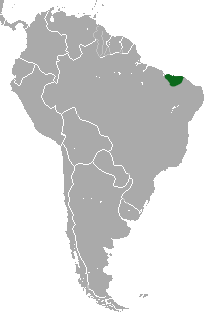Maranhão Howler Monkey
| Maranhão Howler Monkey | ||||||||||||
|---|---|---|---|---|---|---|---|---|---|---|---|---|
| Systematics | ||||||||||||
|
||||||||||||
| Scientific name | ||||||||||||
| Alouatta ululata | ||||||||||||
| Elliot , 1912 |
The Maranhão howler monkey ( Alouatta ululata ) is a controversial species of primate from the family of spider -tailed monkeys (Atelidae). It occurs only in northeastern Brazil . The distribution area of the Maranhão howler monkey includes the northern Maranhão , the northeast corner of Pará and the northern, coastal Piauí , making it the smallest distribution area of all howler monkeys.
features
Maranhão howler monkeys reach head-torso lengths of about 57 cm and have a prehensile tail of about the same length. The males are black with reddish hands and feet, the females are yellowish-brown with sparsely distributed gray hair, so that overall a light olive-colored impression results.
Way of life
Maranhão howler monkeys live in the remains of forest on the northeastern Brazilian Atlantic coast. These include mainly dry forests ( caatinga ), in Maranhão also stocks of the babassu palm ( Attalea speciosa ) and on the coasts of Maranhão and Piauí also mangrove forests . Neither diet nor reproduction have been studied in detail so far.
Systematics
The Maranhão howler monkey was described by the American zoologist Daniel Giraud Elliot in 1912 . For a long time it was considered a subspecies of the red-handed howler monkey ( Alouatta belzebul ), but was raised to species rank in 2006. This is again called into question in a study published in October 2015. A comparison of the cytochrome b genome of both forms showed that the Maranhão howler monkey is deep within the Alouatta belzebul clade.
Danger
The IUCN estimates the population of the species as Critically Endangered. There are probably fewer than 2500 adult specimens left in the wild. The population will decrease at a rate of about 20% in two generations (24 years). The main threats to the species are habitat destruction and hunting.
literature
- AB Rylands & RA Mittermeier: Family Atelidae (Howlers, Spider and Woolly Monkeys and Muriquis). Pages 528 in Russell A. Mittermeier , Anthony B. Rylands & Don E. Wilson : Handbook of the Mammals of the World - Volume: Primates. Lynx Editions, 2013 ISBN 978-8496553897
- Liliana Cortés-Ortiz, Anthony B. Rylands, Russell A. Mittermeier: The Taxonomy of Howler Monkeys: Integrating Old and New Knowledge from Morphological and Genetic Studies. Developments in Primatology: Progress and Prospects 2015, pages 55–84, Springer, New York, DOI: 10.1007 / 978-1-4939-1957-4_3 , ISBN 978-1-4939-1956-7
supporting documents
- ^ Renato Gregorin (2006). Taxonomia e variação geográfica das espécies do gênero Alouatta Lacépède (Primates, Atelidae) no Brasil . Rev. Bras. Zool. 23 (1). doi: 10.1590 / S0101-81752006000100005
- ↑ Maria Carolina Viana, Cibele Rodrigues Bonvicino, Juliana Gonçalves Ferreira, Lendro Jerusalinski, Alfredo Langguth & Héctor Seuánez: Understanding the Relationship Between Alouatta ululata and Alouatta belzebul (Primates: Atelidae) Based on Cytogenetics and Molecular Phylogenetics. Oecologia Australis 19 (1): 173-182 October 2015, DOI: 10.4257 / oeco.2015.1901.11
Web links
- Alouatta ululata in the endangered Red List species the IUCN 2008. Posted by: de Oliveira, MM & Kierulff, MCM, 2008. Accessed June 18, 2015.
